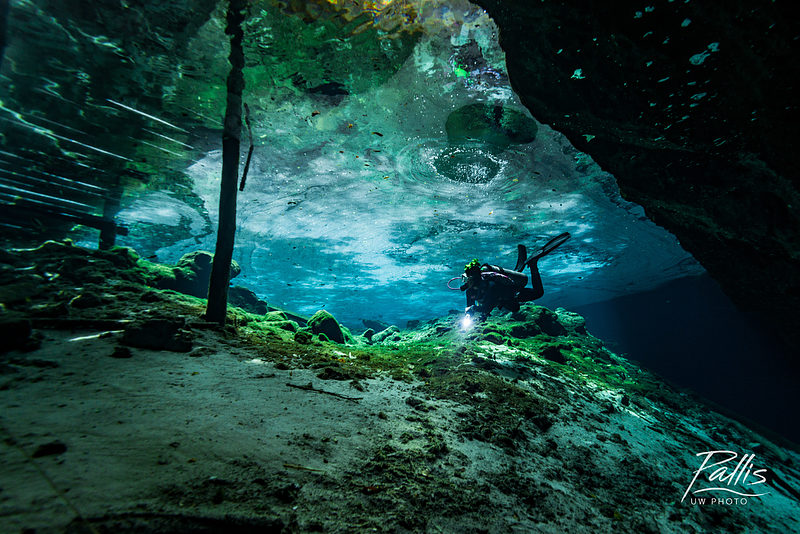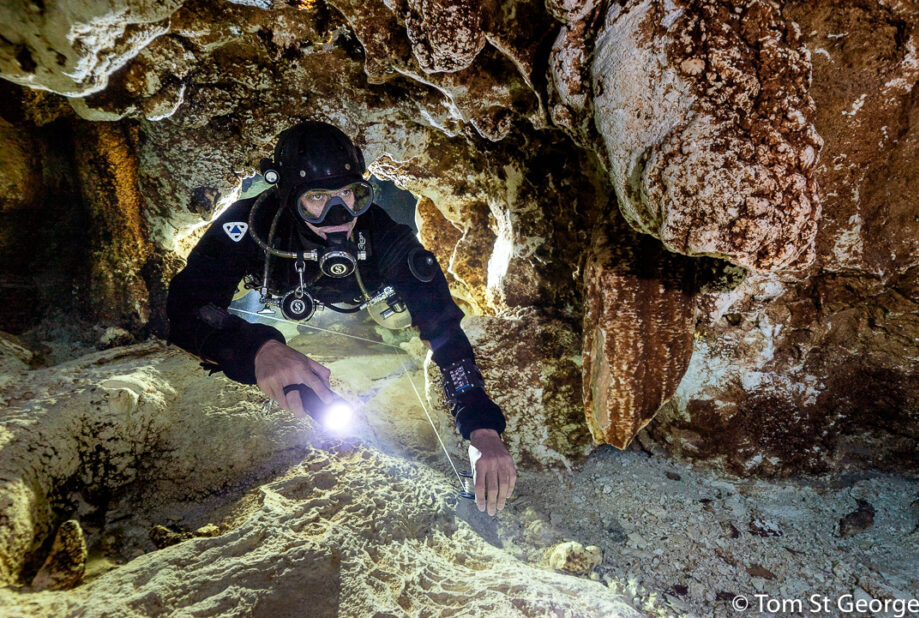Cenote diving from Playa del Carmen
Travel Back In Time & Discover The Mystical Mayan Underwater World
“The cave you fear to enter holds the treasure you seek.” Joseph Campbell
The word ‘cenote’ comes from the Spanish transformation of the Maya ‘dz’onot’, which roughly translates as ‘water-filled cavity’. Cenotes are predominantly found in the northern part of the Yucatan Peninsula where the karstic rock is highly permeable. Rainwater infiltrates the rock, forming a fresh water aquifer flowing over a dense mass of saline water coming in from the sea.
The creation of these cenotes stretches back millions of years, to when the Yucatan Peninsula was below sea level and formed the bed of a shallow ocean. During subsequent ice ages, the sea level fell and the Peninsula was fully exposed, forming dry land covered in heavy vegetation. It was during these periods that a system of caves began to develop. Rainwater and decaying vegetation produced a carbonic acid (similar to carbonated soft drinks) that dissolved the limestone, sometimes creating vertical shafts from the surface and helping to form the cave system. In some areas the ceiling over these underground caves collapsed partially or completely, creating underground air domes or cenotes.
Join us to discover the cenotes from our Dive Center in Playa del Carmen. Scuba diving in the cenotes is the best way to enjoy the cenotes of the Riviera Maya. And if you are not a diver yourself, we also offer snorkeling, cultural and archeological tours to explore the area.
There are numerous cenotes to explore in Playa del Carmen and Tulum area. Each Cenote is very different from one another, and each dive is absolutely unique. One day is definitely not enough time to enjoy all the magic these places have to offer, so make sure to make them your priority as they are unique to the region. Visit our gallery for some impressions of cenote diving.
Cenote diving from Playa del Carmen
“The cave you fear to enter holds the treasure you seek.” Joseph Campbell
Travel Back In Time & Discover The Mystical Mayan Underwater World
The word ‘cenote’ comes from the Spanish transformation of the Maya ‘dz’onot’, which roughly translates as ‘water-filled cavity’. Cenotes are predominantly found in the northern part of the Yucatan Peninsula where the karstic rock is highly permeable. Rainwater infiltrates the rock, forming a fresh water aquifer flowing over a dense mass of saline water coming in from the sea.
The creation of these cenotes stretches back millions of years, to when the Yucatan Peninsula was below sea level and formed the bed of a shallow ocean. During subsequent ice ages, the sea level fell and the Peninsula was fully exposed, forming dry land covered in heavy vegetation. It was during these periods that a system of caves began to develop. Rainwater and decaying vegetation produced a carbonic acid (similar to carbonated soft drinks) that dissolved the limestone, sometimes creating vertical shafts from the surface and helping to form the cave system. In some areas the ceiling over these underground caves collapsed partially or completely, creating underground air domes or cenotes.
Join us to discover the cenotes from our Dive Center in Playa del Carmen. Scuba diving in the cenotes is the best way to enjoy the cenotes of the Riviera Maya. And if you are not a diver yourself, we also offer snorkeling, cultural and archeological tours to explore the area.
There are numerous beautiful cenotes to explore in Playa del Carmen and Tulum area. Each Cenote is very different from one another, and each dive is absolutely unique. One day is definitely not enough time to enjoy all the magic these places have to offer, so make sure to make them your priority as they are unique to the region. Visit our gallery for some impressions of cenote diving.

Cenote Cavern Diving
OW Diver or Equivalent
Cavern Diving in Playa del Carmen, Tulum or Cancún is open to recreational divers from the Open Water Diver level (or equivalent entry levels) under the supervision of our specialized Instructors.
This experience will allow divers to enjoy the magical light shows, crystal clear waters offering limitless visibility, the majestic millennial geological formations and fossils of shells and corals, remains of the ancient coral reef, all of which will happen within the “daylight zone” of the overhead environment.
Cenote Cave Diving
Intro To Cave Diver Min.
Cenote Cave Diving is technical diving and is open only to certified cave divers. In Mexico, this certification requires an extensive training and specialized equipment. This experience will allow the divers to penetrate the overhead environment beyond the “daylight zone” to explore the extended complex navigation of the flooded underwater cave systems and explore what only a few privileged divers have been.
If you would like to get certified for cave diving, please refer to our cave diving courses section and contact us for more info.


Cenote Cavern Diving
Open Water Diver or Equivalent
Cavern Diving in Playa del Carmen, Tulum or Cancún is open to recreational divers from the Open Water Diver level (or equivalent entry levels) under the supervision of our experienced specialized Instructors.
This experience will allow divers to enjoy the magical light shows, crystal clear waters offering limitless visibility, the majestic millennial geological formations and fossils of shells and corals, remains of the ancient coral reef, all of which will happen within the “daylight zone” of the overhead environment.

Cenote Cave Diving
Intro To Cave Diver Min.
Cenote Cave Diving is technical diving and is open only to certified cave divers. In Mexico, this certification requires an extensive training and specialized equipment. This experience will allow the divers to penetrate the overhead environment beyond the “daylight zone” to explore the extended complex navigation of the flooded underwater cave systems and explore what only a few privileged divers have been.
If you would like to get certified for cave diving, please refer to our cave diving courses section and contact us for more info.

